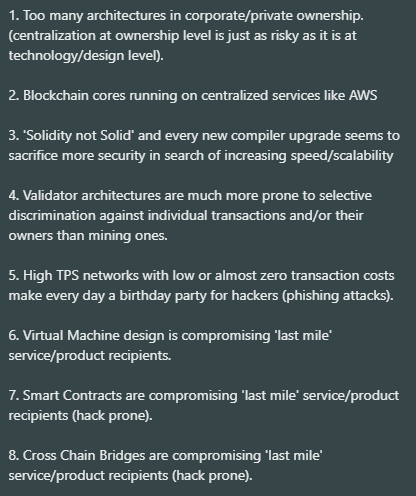
Many think I have strong opinions on networks that offer ‘EVM Compatibility’.
Some consider me an ‘ETH hater’, which is a bit unfair, because I’ve pointed to many use cases where the model makes sense, but I am very clear technically on two different things…
- The extent to which the Ethereum L1 itself has become increasingly less secure since ‘The Merge’
- The increasing risks to user autonomy and security posed by completely different scaling solutions, layers and networks which exhibit ‘EVM Compatibility’.
These two things are not the same.
Register for Tekedia Mini-MBA edition 19 (Feb 9 – May 2, 2026): big discounts for early bird.
Tekedia AI in Business Masterclass opens registrations.
Join Tekedia Capital Syndicate and co-invest in great global startups.
Register for Tekedia AI Lab: From Technical Design to Deployment (next edition begins Jan 24 2026).
Though, I’ve also pointed out, that Ethereum itself is also carrying out architectural build-out to extend its functions to improve its speed, as it attempts to compete head-to-head for ‘last mile’ business with the networks built off it, or in its ecosystem.
As it becomes more centralized, it has more investors, and they are only interested in one thing – a pay day.
These weaken its security, but some changes, may also oblige others in the ‘ecosystem’ to change in order to preserve compatibility.
In some ways, if Eth buildout itself ‘lurches’ in the direction of more TPS (Transactions Per Second), and cheaper minting with a trade off against security, it may compound the weaknesses of other networks in the ecosystem.
I’ve warned many times, mostly in responses to content on LinkedIn rather than my own articles, that multipliers of risk compound across EVM Compatible Networks.

Nevertheless, I want to pause that there… because I’ve also said the whole concept of scaling needs to be revisited…
In some ways, the flawed designs that have brought so many hacks and exploits on EVMs, need to be abandoned if and when scaling is attempted off other blockchains.
For example, whether we build out off Bitcoin, Solana, Handshake or a blockchain called ‘poop’, it will be pointless if we simply use the same Modus Operandum that has resulted in ‘Proof of Hack Pandemic’ on EVMs.
Case in point, after all the disasters that have come out of the evolution of ERC 20, its not rocket science to realize if we go somewhere else, we need something different, something new.
Unfortunately for Bitcoin dev. Enthusiasts, BRC 20 already exists.
This reminds me of the evolution of the oil industry in Texas, US. Even worse than the US Goldrush before it, indiscriminate and toxic exploitation of land created environmental damage that won’t recover for decades, in some cases, centuries.
Community pressure brought about environmental legislation, so newer (more expensive) ways had to be found to extract oil.

What did the extraction companies do? Instead of embarking on a road to continuous improvement, they went prospecting all over the world, manipulating easily corruptible indigenous rule structures, and inflicting irreversible damage on environments, and local livelihoods, hitherto vastly dependant on agriculture, fisheries and forestry.
Similar things happened in Europe among ‘Sex Criminals’. When the legislation noose began to tighten, they began to indulge in ‘Sex Crime Tourism’ to countries with weaker enforcement like Cambodia and Vietnam. Such destinations were made notorious by the disgraced ex-singer Paul Gadd (Garry Glitter) at the end of the last century.
We just can’t afford exporting malpractice to sovereignties less equipped to deal with them. The answer instead is to come with a solution.

Blockchain Ecosystems are like virtual sovereign territories. The obsession with increasing TPS (Transactions Per Second) on EVM Compatible Networks has made them become the most hacked cryptographic environment, accounting for over 90% of losses, with Smart Contracts and Cross Chain Bridges being top points of intrusion.
While building out on other ecosystems, like Bitcoin, Handshake, Solana and Cardano seems interesting, the model needs to change, and we need to have ‘lessons learned’ from the things that happen on EVM Compatibles that have, and continue, to lose folk large sums of money and destroy hopes and dreams.
The ‘Smart Contract’ model needs to be binned, and in particular, we need to avoid creating (xxx)RC – 20 type token regimes in these other ecosystems.
Otherwise, we are leaving the blockchain world equivalent of the Environmental and Sex Criminals, who already poisoned the EVM landscape after ‘the merge’, run amok on naïve and under-exploited virtual sovereignties.
Now, Naga Avan-Nomayo , for crypto.news reports that Conflux Network is contributing to bringing the Bitcoin Blockchain further down that road best not travelled.
Conflux, a China based Network is introducing an EVM-compatible layer-2 solution off the Bitcoin Blockchain, which is expected to go live in March.
‘According to Conflux, users can move Bitcoin (BTC) and inscription-powered assets between its blockchain and Bitcoin’s ecosystem. The new L2 network will run atop the main Conflux chain and use BTC for gas fees while supporting Ethereum-based smart contracts via the Ethereum Virtual Machine (EVM) standard.’
9ja Cosmos is here…
Get your .9jacom and .9javerse Web 3 domains for $2 at:
Visit 9ja Cosmos LinkedIn Page
Preview our Sino Amazon/Sinosignia releases



